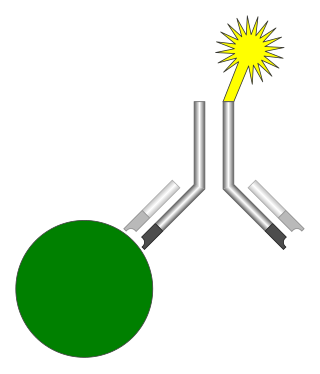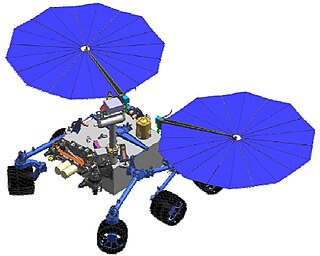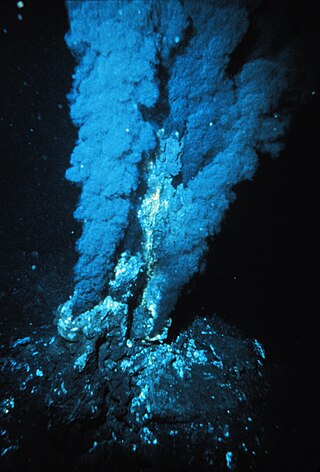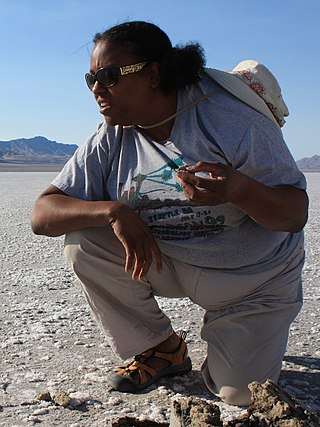
The possibility of life on Mars is a subject of interest in astrobiology due to the planet's proximity and similarities to Earth. To date, no proof of past or present life has been found on Mars. Cumulative evidence suggests that during the ancient Noachian time period, the surface environment of Mars had liquid water and may have been habitable for microorganisms, but habitable conditions do not necessarily indicate life.
A biosignature is any substance – such as an element, isotope, or molecule – or phenomenon that provides scientific evidence of past or present life. Measurable attributes of life include its complex physical or chemical structures and its use of free energy and the production of biomass and wastes. A biosignature can provide evidence for living organisms outside the Earth and can be directly or indirectly detected by searching for their unique byproducts.

In 1976 two identical Viking program landers each carried four types of biological experiments to the surface of Mars. The first successful Mars landers, Viking 1 and Viking 2, then carried out experiments to look for biosignatures of microbial life on Mars. The landers each used a robotic arm to pick up and place soil samples into sealed test containers on the craft.

An immunoassay (IA) is a biochemical test that measures the presence or concentration of a macromolecule or a small molecule in a solution through the use of an antibody (usually) or an antigen (sometimes). The molecule detected by the immunoassay is often referred to as an "analyte" and is in many cases a protein, although it may be other kinds of molecules, of different sizes and types, as long as the proper antibodies that have the required properties for the assay are developed. Analytes in biological liquids such as serum or urine are frequently measured using immunoassays for medical and research purposes.

The Astrobiology Field Laboratory (AFL) was a proposed NASA unmanned spacecraft that would have conducted a robotic search for life on Mars. This proposed mission, which was not funded, would have landed a rover on Mars in 2016 and explore a site for habitat. Examples of such sites are an active or extinct hydrothermal deposit, a dry lake or a specific polar site.

An antibody microarray is a specific form of protein microarray. In this technology, a collection of captured antibodies are spotted and fixed on a solid surface such as glass, plastic, membrane, or silicon chip, and the interaction between the antibody and its target antigen is detected. Antibody microarrays are often used for detecting protein expression from various biofluids including serum, plasma and cell or tissue lysates. Antibody arrays may be used for both basic research and medical and diagnostic applications.

The Mars Astrobiology Explorer-Cacher (MAX-C), also known as Mars 2018 mission was a NASA concept for a Mars rover mission, proposed to be launched in 2018 together with the European ExoMars rover. The MAX-C rover concept was cancelled in April 2011 due to budget cuts.

Astrobiology Science and Technology for Exploring Planets (ASTEP) was a program established by NASA to sponsor research projects that advance the technology and techniques used in planetary exploration. The objective was to enable the study of astrobiology and to aid the planning of extraterrestrial exploration missions while prioritizing science, technology, and field campaigns.
Interplanetary contamination refers to biological contamination of a planetary body by a space probe or spacecraft, either deliberate or unintentional.
Terrestrial analogue sites are places on Earth with assumed past or present geological, environmental or biological conditions of a celestial body such as the Moon or Mars. Analogue sites are used in the frame of space exploration to either study geological or biological processes observed on other planets, or to prepare astronauts for surface extra-vehicular activity.
The Biological Oxidant and Life Detection (BOLD) is a concept mission to Mars focused on searching for evidence or biosignatures of microscopic life on Mars. The BOLD mission objective would be to quantify the amount of hydrogen peroxide existing in the Martian soil and to test for processes typically associated with life. Six landing packages are projected to impact 'softly' on Mars that include a limited power supply, a set of oxidant and life detection experiments, and a transmitter, which is able to transmit information via an existing Mars orbiter back to Earth. The mission was first proposed in 2012.
MELOS is a Japanese rover mission concept under study for an engineering demonstration of precision landing, and to look for possible biosignatures on Mars using a rover. JAXA has not published updates since 2015.

Icebreaker Life is a Mars lander mission concept proposed to NASA's Discovery Program. The mission involves a stationary lander that would be a near copy of the successful 2008 Phoenix and InSight spacecraft, but would carry an astrobiology scientific payload, including a drill to sample ice-cemented ground in the northern plains to conduct a search for biosignatures of current or past life on Mars.
Mars habitability analogue environments on Earth are environments that share potentially relevant astrobiological conditions with Mars. These include sites that are analogues of potential subsurface habitats, and deep subsurface habitats.
The Mars Organic Molecule Analyser (MOMA) is a mass spectrometer-based instrument on board the Rosalind Franklin rover to be launched in 2028 to Mars on an astrobiology mission. It will search for organic compounds in the collected soil samples. By characterizing the molecular structures of detected organics, MOMA can provide insights into potential molecular biosignatures. MOMA will be able to detect organic molecules at concentrations as low as 10 parts-per-billion by weight (ppbw). MOMA examines solid crushed samples exclusively; it does not perform atmospheric analyses.
Mars Multispectral Imager for Subsurface Studies (MA-MISS) is a miniaturized imaging spectrometer designed to provide imaging and spectra by reflectance in the near-infrared (NIR) wavelength region and determine the mineral composition and stratigraphy. The instrument is part of the science payload on board the European Rosalind Franklin rover, tasked to search for biosignatures, and scheduled to land on Mars in spring 2023. MA-MISS is essentially inside a drill on the Rover, and will take measurements of the sub-surface directly.

MicrOmega-IR is an infrared hyperspectral microscope that is part of the science payload on board the European Rosalind Franklin rover, tasked to search for biosignatures on Mars. The rover is planned to land on Mars in the mid- or late 2020s. MicrOmega-IR will analyse in situ the powder material derived from crushed samples collected by the rover's core drill.
Raman Laser Spectrometer (RLS) is a miniature Raman spectrometer that is part of the science payload on board the European Space Agency'sRosalind Franklin rover, tasked to search for biosignatures and biomarkers on Mars. The rover is planned to be launched in August–October 2022 and land on Mars in spring 2023.
ADRON-RM is a neutron spectrometer to search for subsurface water ice and hydrated minerals. This analyser is part of the science payload on board the European Space Agency'sRosalind Franklin rover, tasked to search for biosignatures and biomarkers on Mars. The rover is planned to be launched in August–October 2022 and land on Mars in spring 2023.

Kennda Lian Lynch is an American astrobiologist and geomicrobiologist who studies polyextremophiles. She has primarily been affiliated with NASA. She identifies environments on Earth with characteristics that may be similar to environments on other planets, and creates models that help identify characteristics that would indicate an environment might host life. Lynch also identifies what biosignatures might look like on other planets. Much of Lynch's research on analog environments has taken place in the Pilot Valley Basin in the Great Salt Desert of northwestern Utah, U.S. Her work in that paleolake basin informed the landing location of NASA's Perseverance Rover mission—at another paleolake basin called Jezero Crater. Jim Greene, Chief Scientist at NASA, called Lynch "a perfect expert to be involved in the Perseverance rover." Helping to select the proper landing site for NASA's first manned mission to Mars in 2035 is another of Lynch's projects. Lynch has appeared in multiple television series, as well as The New York Times, Nature, Scientific American, and Popular Science. Cell Press designated Lynch one of the most inspiring Black scientists in the United States.










